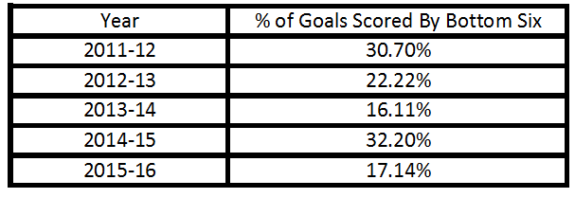Over the past offseason, general manager Jim Rutherford continued to make his mark on the Pittsburgh Penguins. It was an offseason that saw the controversial Brandon Sutter traded and the Penguins made a number of cost-effective and analytically driven moves.
On paper, the Pittsburgh Penguins were going to have the deepest group of forwards that they’ve had in years. Much of that is due to their current salary structure, which allocates over 63% of available cap space to forwards.
Former head coach Mike Johnston said this earlier this season about Rutherford’s offseason actions.
I think Jim Rutherford talked this summer about trying to have a balance in scoring and depth through our four lines, not only in scoring but sort of sharing the minutes.
The team brought in free agents like Matt Cullen and Eric Fehr on team friendly contracts and acquired Nick Bonino in the trading of Sutter. Add everything up and this team looked ready to deploy four legitimate scoring lines. Cullen came in scoring .51 points-per-game while Fehr was at .37 and Bonino was at .43. This was quite a departure from common bottom-six forwards that the Penguins had employed in the past. Craig Adams produced .17 points-per-game, while Tanner glass netted .13 and Zach Sill barely contributed with .05 points-per-game.
Pittsburgh Penguins Bottom-Six Not Living Up To Expectations
All of this might sound great, but history is judged on execution, not promise. The Penguins started the season playing trudgingly boring hockey. Johnston preached a solid defensive game during the 2015-16 season, a dramatic change from his up-tempo puck possession tactics in the 2014-15 season.
This season, the Penguins regular bottom-six forwards have contributed 24 goals, of the Penguins 140 total. That’s 17.14% of the Penguins total goals scored this season, the second lowest percentage of the last five seasons.
Here’s a breakdown of the bottom-six percentage of goals by year.

And before I go any further, let’s give the 2013-14 season some context, the team’s top goal scorers in the bottom-six were Brandon Sutter, Pascal Dupuis, Brian Gibbons, Craig Adams, Jayson Megna and Tanner Glass.
Gibbons and Megna are playing in the AHL, Adams retired after a steep decline in performance, Glass has scored nine points in 99 NHL games since leaving Pittsburgh. While Sutter and Dupuis were both valued members of the Penguins, both have moved on for respective reasons.
Sutter was traded due to his impending free agent status and to improve team depth and Dupuis is physically unable to play hockey anymore due to blood clots.
When you look at everything, the 2013-14 Pittsburgh Penguins didn’t exactly employ an exceptional bottom-six group of forwards.
That brings us back to the 2015-16 season where the Penguins have their best group of bottom-six forwards, on paper, in the last five years, yet are contributing goals at an extremely low pace.
A common defense of this is that Johnston’s system stifled offensive production, look at Sidney Crosby’s production early in the season, but these players have had time under Sullivan.
Another factor hampering their performance has been injuries, Fehr, Bennett and Bonino have been out for quite some time and their absence has been noticed. But there’s something that I keep coming back to, their individual production.
In a defensively focused system, where most players had great Corsi For percentages, only Bonino and Cullen have been performing above their career average, and that’s just barely. In terms of goals and points per-sixty, only Bennett has seen an increase in goals per-sixty.
And yes, this is including Cullen’s time alongside Carl Hagelin and Phil Kessel due to the recent injury to Evgeni Malkin. His time centering the second line has increased his metrics across the board.
I went ahead and compared these players production this season with their career averages and here’s what the results look like.

The only player you have to give a break to is Dupuis, he was coming back from numerous injuries and serious health conditions. He only played a few games and was ineffective, a sign that his career was winding down to those on the outside.
This isn’t the first time that notable players have came to Pittsburgh and struggled with injuries and lack of production.
Maybe when the team gets healthy again these valuable depth players and crank up their production. However, what was once a promising bottom-six forward group has been one big disappointment.
Hopefully these forwards can regain their scoring touch as the NHL season rapidly flies by because without the support of a strong bottom-six, it’s hard to imagine the Penguins going far in the playoffs.